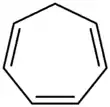Cycloheptatriene
Cycloheptatriene (CHT) is an organic compound with the formula C7H8. It is a closed ring of seven carbon atoms joined by three double bonds (as the name implies) and four single bonds. This colourless liquid has been of recurring theoretical interest in organic chemistry. It is a ligand in organometallic chemistry and a building block in organic synthesis. Cycloheptatriene is not aromatic, as reflected by the nonplanarity of the methylene bridge (-CH2-) with respect to the other atoms; however the related tropylium cation is.
| |||
| Names | |||
|---|---|---|---|
| Preferred IUPAC name
Cyclohepta-1,3,5-triene[1] | |||
| Other names
1,3,5-Cycloheptatriene 1H-[7]Annulene CHT Tropilidene | |||
| Identifiers | |||
3D model (JSmol) |
|||
| 506066 | |||
| ChEBI | |||
| ChemSpider | |||
| ECHA InfoCard | 100.008.061 | ||
| EC Number |
| ||
| 1943 | |||
PubChem CID |
|||
| UNII | |||
| UN number | 2603 | ||
CompTox Dashboard (EPA) |
|||
| |||
| |||
| Properties | |||
| C7H8 | |||
| Molar mass | 92.141 g·mol−1 | ||
| Density | 0.888 g/mL at 25 °C | ||
| Melting point | −80 °C (−112 °F; 193 K) | ||
| Boiling point | 116 °C (241 °F; 389 K) | ||
| Insoluble in water | |||
| Acidity (pKa) | 36 | ||
| Hazards | |||
| GHS pictograms |     | ||
| GHS Signal word | Danger | ||
| H225, H301, H304, H311, H315, H319, H335 | |||
| P210, P233, P240, P241, P242, P243, P261, P264, P270, P271, P280, P301+310, P302+352, P303+361+353, P304+340, P305+351+338, P312, P321, P322, P330, P331, P332+313, P337+313, P361, P362 | |||
Except where otherwise noted, data are given for materials in their standard state (at 25 °C [77 °F], 100 kPa). | |||
| Infobox references | |||
Synthesis
Albert Ladenburg first generated cycloheptatriene in 1881 by the decomposition of tropine.[2][3] The structure was finally proven by the synthesis of Richard Willstätter in 1901. This synthesis started from cycloheptanone and established the seven membered ring structure of the compound.[4]
Cycloheptatriene can be obtained in the laboratory by photochemical reaction of benzene with diazomethane or the pyrolysis of the adduct of cyclohexene and dichlorocarbene.[5] A related classic synthesis for cycloheptatriene derivatives, the Buchner ring enlargement, starts with the reaction of benzene with ethyl diazoacetate to give the corresponding norcaradiene ethyl ester, which then undergoes a thermally-allowed electrocyclic ring expansion to give 1,3,5-cycloheptatriene 7-carboxylic acid ethyl ester.[6][7]

- Selected cycloheptatriene derivatives
 Heptalene – composed of two fused cycloheptatriene rings.
Heptalene – composed of two fused cycloheptatriene rings. Azulene – composed of fused cyclopentadiene and cycloheptatriene rings.
Azulene – composed of fused cyclopentadiene and cycloheptatriene rings. Sesquifulvalene – composed of linked cyclopentadiene and cycloheptatriene rings.
Sesquifulvalene – composed of linked cyclopentadiene and cycloheptatriene rings. Elassovalene – composed of one cycloheptatriene and two fused cyclopentene rings.
Elassovalene – composed of one cycloheptatriene and two fused cyclopentene rings. Tropone – composed of cycloheptatriene ring and carbonyl group.
Tropone – composed of cycloheptatriene ring and carbonyl group.
 Hinokitiol – composed of cycloheptatriene ring, isopropyl, carbonyl and hydroxy groups (isopropyl cycloheptatrienolone).
Hinokitiol – composed of cycloheptatriene ring, isopropyl, carbonyl and hydroxy groups (isopropyl cycloheptatrienolone).
Reactions
Removal of a hydride ion from the methylene bridge gives the planar and aromatic cycloheptatriene cation, also called the tropylium ion. A practical route to this cation employs PCl5 as the oxidant.[8] CHT behaves as a diene in Diels–Alder reactions. Many metal complexes of cycloheptatriene are known, including Cr(CO)3(C7H8) [9] and cycloheptatrienemolybdenum tricarbonyl.[10]
3.png.webp)
Cyclooctatetraene and cycloheptatriene are used as a triplet quencher for rhodamine 6G dye lasers.[11][12]
See also
References
- Nomenclature of Organic Chemistry : IUPAC Recommendations and Preferred Names 2013 (Blue Book). Cambridge: The Royal Society of Chemistry. 2014. p. 223. doi:10.1039/9781849733069-FP001. ISBN 978-0-85404-182-4.
- A. Ladenburg (1883). "Die Constitution des Atropins". Justus Liebig's Annalen der Chemie. 217 (1): 74–149. doi:10.1002/jlac.18832170107.
- A. Ladenburg (1881). "Die Zerlegung des Tropines". Berichte der Deutschen Chemischen Gesellschaft. 14 (2): 2126–2131. doi:10.1002/cber.188101402127.
- R. Willstätter (1901). "Synthesen in der Tropingruppe. I. Synthese des Tropilidens". Justus Liebig's Annalen der Chemie. 317 (2): 204–265. doi:10.1002/jlac.19013170206.
- H.E. Winberg (1959). "Synthesis of Cycloheptatriene". Journal of Organic Chemistry. 24 (2): 264–265. doi:10.1021/jo01084a635.
- Buchner, et al., Ber., 18, 2377 (1885);
- For a variation: Irvin Smith Lee; Tawney Pliny O (1934). "Studies on the Polymethylbenzenes. IX. Addition of Ethyl Diazoacetate to Durene". J. Am. Chem. Soc. 56 (10): 2167–2169. doi:10.1021/ja01325a054.
- Conrow, K. (1973). "Tropylium Fluoroborate" (PDF). Organic Syntheses, Collected Volume. 5: 1138.
- James H. Rigby, Kevin R. Fales (2004). "7α-ACETOXY-(1Hβ, 6Hβ)-BICYCLO[4.4.1]UNDECA-2,4,8-TRIENE VIA CHROMIUM-MEDIATED HIGHER ORDER CYCLOADDITION". Organic Syntheses.; Collective Volume, 10, p. 1
- Green, Malcolm L. H.; Ng, Dennis K. P. (1995). "Cycloheptatriene and -enyl Complexes of the Early Transition Metals". Chemical Reviews. 95 (2): 439–473. doi:10.1021/cr00034a006.
- Tomi Nath Das; K. Indira Priyadarsini (1994). "Triplet of Cyclooctatetraene : Reactivity and Properties". Journal of the Chemical Society, Faraday Transactions. 90 (7): 963–968. doi:10.1039/ft9949000963.
- R. Pappalardo; H. Samelson; A. Lempicki (1970). "Long Pulse Laser Emission From Rhodamine 6G Using Cyclooctatetraene". Applied Physics Letters. 16 (7): 267–269. Bibcode:1970ApPhL..16..267P. doi:10.1063/1.1653190.

